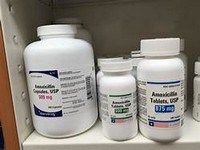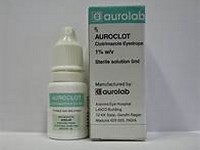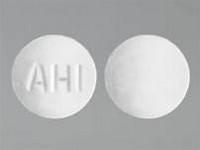Erythromycin

Erythromycin
CLINICAL USE
Antibacterial agent
DOSE IN NORMAL RENAL FUNCTION
IV: 25–50 mg/kg/dayOral: 250–500 mg every 6 hours or 0.5–1 g every 12 hoursMaximum 4 g daily
PHARMACOKINETICS
Molecular weight :733.9 %Protein binding :70–95 %Excreted unchanged in urine : 2–15 Volume of distribution (L/kg) :0.6–1.2 (increased in CKD 5)half-life – normal/ESRD (hrs) :1.5–2/4–7 DOSE IN RENAL IMPAIRMENT
GFR (mL/MIN)
20 to 50 : Dose as in normal renal function 10 to 20 : Dose as in normal renal function <10 : 50–75 % of normal dose; maximum 2 g daily DOSE IN PATIENTS UNDERGOING RENAL REPLACEMENT THERAPIES
CAPD :Not dialysed. Dose as in GFR <10 mL/min HD :Not dialysed. Dose as in GFR <10 mL/min HDF/high flux :Unknown dialysability. Dose as in GFR <10 mL/minCAV/VVHD :Unknown dialysability. Dose as in normal renal function IMPORTANT DRUG INTERACTIONS
Potentially hazardous interactions with other drugsAvoid concomitant use with reboxetine and cilostazolAnti-arrhythmics: increased risk of ventricular arrhythmias with parenteral erythromycin and amiodarone – avoid concomitant use; increased toxicity with disopyramideAntibacterials: increased risk of ventricular arrhythmias with moxifloxacin and parenteral erythromycin avoid concomitant use; increased rifabutin concentrationAnticoagulants: enhanced effect of coumarinsAnti-epileptics: increased carbamazepine concentration and possibly valproateAntihistamines: possibly increases loratadine concentration; inhibits mizolastine metabolism – avoid concomitant useAntimalarials: avoid concomitant administration with artemether/lumefantrineAntimuscarinics: avoid concomitant use with tolterodineAntipsychotics: increased risk of ventricular arrhythmias with amisulpride and parenteral erythromycin avoid concomitant use; possibly increases clozapine concentration and possibly increased risk of convulsions; possibly increased risk of ventricular arrhythmias with pimozide and sertindole – avoid concomitant use; possibly increased quetiapine concentrationAntivirals: concentration of both drugs increased with amprenavir; concentration increased by ritonavirAnxiolytics and hypnotics: inhibits midazolam and zopiclone metabolism; increases buspirone concentrationAtomoxetine: increased risk of ventricular arrhythmias with parenteral erythromycin Calcium-channel blockers: possibly inhibit metabolism of felodipine and verapamil; avoid concomitant use with lercanidipineCiclosporin: markedly elevated ciclosporin blood levels – decreased levels on withdrawing drug. Monitor blood levels of ciclosporin carefully and adjust dose promptly as necessaryColchicine: increased risk of colchicine toxicityCytotoxics: possible interaction with docetaxol; increases vinblastine toxicity – avoid concomitant use Diuretics: increased eplerenone concentration –reduce eplerenone dose Ergot alkaloids: increase risk of ergotism – avoid concomitant use5HT 1 agonists: increased eletriptan concentration – avoid concomitant useIvabradine: increased risk of ventricular arrhythmias – avoid concomitant use.278 eRYtHROMYCINLipid-lowering drugs: increased risk of myopathy; concentration of rosuvastatin reduced Pentamidine: increased risk of ventricular arrhythmias with pentamidineSirolimus: concentration of both drugs increased Tacrolimus: markedly elevated tacrolimus blood levels – decreased levels on withdrawing drug. Monitor blood levels of tacrolimus carefully and adjust dose promptly as necessaryTheophylline: inhibits theophylline metabolism; if erythromycin given orally decreased erythromycin concentration ADMINISTRATION
Reconstition
1 g with 20 mL water for injection, then dilute resultant solution further to 1–5 mg/mL Route
IV, oral Rate of Administration
20–60 minutes using constant rate infusion pumpComments
Use central line if concentration greater than 5 mg/mL; if >10 mg/mL monitor carefully (some units use 1 g in 100 mL of sodium chloride 0.9%). (UK Critical Care Group, Minimum Infusion Volumes for fluid restricted critically ill patients, 3rd Edition, 2006) OTHER INFORMATION
May also give one third of daily dose by infusion over 8 hours peripherally at concentration of 1 g/250 mL (4 mg/mL). Repeat 8 hourly, i.e. continuouslyIncreased risk of ototoxicity in renal impairmentAvoid peaks produced by oral twice-daily dosing, i.e. dose 4 times dailyMonitor closely for thrombophlebitic reactions at site of infusion.
See how to identify renal failure stages according to GFR calculation
See how to diagnose irreversible renal disease
Home









